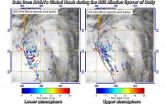(Press-News.org) NASA has Tropical Storm Dolly covered by satellite and the remotely piloted Global Hawk aircraft. Both captured data on Dolly before it made landfall in eastern Mexico.
The MODIS or Moderate Resolution Imaging Spectroradiometer instrument aboard NASA's Terra satellite took an image of Tropical Storms Norbert in the Eastern Pacific and Dolly in the Gulf of Mexico at 1:30 p.m. EDT on Sept. 2. The image showed Dolly is a much more organized storm than Norbert, and revealed Dolly's strongest, towering thunderstorms around the center of circulation. Norbert is close to the western coast of Mexico, so the country has tropical storms to the east and west. The image was created by the NASA MODIS Rapid Response Team at NASA's Goddard Space Flight Center in Greenbelt, Maryland.
At 11 p.m. EDT on September 2, Dolly made landfall between Tampico and Cabo Rojo, near latitude 21.9 north and longitude 97.7 west.
One of NASA's unmanned Global Hawk aircraft number 872 surveyed Tropical Storm Dolly during the night-time hours of September 2 as part of NASA's latest hurricane airborne mission known as the Hurricane and Severe Storm Sentinel, or HS3 mission.
"We saw winds at low levels (near 850 millibars) up to about 35 to 40 knots (40 to 46 mph) and a reasonably depicted cyclonic circulation," said HS3 Principal Investigator, Dr. Scott Braun of NASA's Goddard Space Flight Center in Greenbelt, Maryland. "The data at 150 millibars (high in the atmosphere) shows the strong outflow from the storm to the east and southeast."
In the image, the dropsonde data gathered from NASA's Global Hawk were adjusted over the satellite image of the storm to compensate for the storm's movement. As a result, although the image makes dropsonde data look as if it were over eastern Mexico, there were no drops over the country. The data was just shifted to match the satellite image. All dropsondes were dropped over the Gulf of Mexico.
NASA's HS3 mission returned to NASA Wallops Flight Facility, Wallops Island, Virginia for the third year to investigate the processes that underlie hurricane formation and intensity change in the Atlantic Ocean basin. HS3 is a collaborative effort that brings together several NASA centers with federal and university partners.
By 8 a.m. EDT (1200 UTC) on September 3, Dolly had weakened to a depression with maximum sustained winds near 35 mph (55 kph). The National Hurricane Center (NHC) expects Dolly to weaken quickly and dissipate by the end of the day on September 3. Dolly was centered near latitude 21.7 north and longitude 98.8 west, about 65 miles (110 km) west-southwest of Tampico, Mexico. Dolly was moving toward the west near 8 mph (13 kph) and is expected to continue in that direction for the next day or so taking Dolly farther inland.
As with any tropical cyclone that makes landfall, heavy rainfall is always a concern. The NHC expects Dolly to produce rainfall amounts of 5 to 10 inches with isolated maximum amounts of 15 inches across much of Tamaulipas and Nuevo Leon...as well as northern Veracruz and eastern San Luis Potosi, Mexico through Wednesday evening. This rainfall is expected to cause life-threatening flash floods and mud slides in areas of mountainous terrain.
For NASA's HS3 mission: www.nasa.gov/hs3
INFORMATION:
NASA's HS3 hurricane mission and Terra satellite take on Tropical Storm Dolly
2014-09-03
ELSE PRESS RELEASES FROM THIS DATE:
Researchers discover new clues to determining the solar cycle
2014-09-03
Approximately every 11 years, the sun undergoes a complete personality change from quiet and calm to violently active. The height of the sun's activity, known as solar maximum, is a time of numerous sunspots, punctuated with profound eruptions that send radiation and solar particles out into the far reaches of space.
However, the timing of the solar cycle is far from precise. Since humans began regularly recording sunspots in the 17th century, the time between successive solar maxima has been as short as nine years, but as long as 14, making it hard to determine its cause. ...
NASA sees Tropical Storm Norbert affecting Mexico's west coast
2014-09-03
Tropical Storm Norbert has now triggered Tropical Storm Warnings for Mexico's West Coast, and NASA's Terra satellite showed how close it is to land.
On Wednesday, September 3, the National Hurricane Center (NHC) issued a Tropical Storm Warning from La Paz to Santa Fe, Mexico. There is also a Tropical Storm Watch in effect from north of Santa Fe northward to Cabo San Lazaro, Mexico.
he MODIS or Moderate Resolution Imaging Spectroradiometer instrument aboard NASA's Terra satellite took an image of Tropical Storms Norbert in the Eastern Pacific and Dolly in the Gulf of ...
Climate change science aided by huge but 'invisible' efforts of amateurs
2014-09-03
Ithaca, N.Y.— Hundreds of thousands of volunteer data collectors are due for some thanks from scientists, according to a new paper that reveals the role of citizen science in studies of birds and climate change. Data collected by amateurs underpins up to 77 percent of the studies in this field, but that fact is largely invisible by the time the research appears in journals, according to a study published today in the open-access journal PLOS ONE:
http://www.plosone.org/article/info%3Adoi%2F10.1371%2Fjournal.pone.0106508
"Our paper is a chance to say thank you to the ...
Forming consensus in social networks
2014-09-03
CORAL GABLES, Fla. (Sept. 3, 2014) -- Social networks have become a dominant force in society. Family, friends, peers, community leaders and media communicators are all part of people's social networks. Individuals within a network may have different opinions on important issues, but it's their collective actions that determine the path society takes.
To understand the process through which we operate as a group, and to explain why we do what we do, researchers have developed a novel computational model and the corresponding conditions for reaching consensus in a wide ...
Leaky gut -- A source of non-AIDS complications in HIV-positive patients
2014-09-03
Human immunodeficiency virus (HIV) infection is no longer a fatal condition, thanks to newer medications inhibiting the retrovirus, but a puzzling phenomenon has surfaced among these patients — non-AIDS complications. Scientists at Case Western Reserve University School of Medicine have resolved the mystery with their discovery of the leaky gut as the offender. Bacterial products seep out of the colon, trigger inflammation throughout the body and set into motion the processes of cardiovascular, neurodegenerative, chronic kidney and metabolic diseases, and cancer. Their ...
Study links healthy sleep duration to less sick time from work
2014-09-03
DARIEN, IL – New research suggests that sleeping 7 to 8 hours per night is associated with the lowest risk of absence from work due to sickness. The results underscore the importance of the "Sleep Well, Be Well" campaign of the National Healthy Sleep Awareness Project, a collaboration between the Centers for Disease Control and Prevention, American Academy of Sleep Medicine, Sleep Research Society and other partners.
Results show that the risk of an extended absence from work due to sickness rose sharply among those who reported sleeping less than 6 hours or more than ...
New deep sea mushroom-shaped organisms discovered
2014-09-03
Scientists discovered two new species of sea-dwelling, mushroom-shaped organisms, according to a study published September 3, 2014 in the open-access journal PLOS ONE by Jean Just from University of Copenhagen, Denmark, and colleagues.
Scientists classify organisms based on shared characteristics using a taxonomic rank, including kingdom, phylum, and species. In 1986, the authors of this study collected organisms at 400 and 1000 meters deep on the south-east Australian continental slope and only just recently isolated two types of mushroom-shaped organisms that they couldn't ...
IU researchers isolate process that damages lungs of donors with traumatic brain injury
2014-09-03
INDIANAPOLIS -- Few people would guess that some of the most detrimental damage from a traumatic brain injury is to the lungs, but transplant specialists are keenly aware of this phenomenon. Indiana University research published Sept. 3 in Science Translational Medicine sheds light on the potentially lethal process.
Research conducted by an interdisciplinary team co-led by Fletcher A. White, Ph.D., the Vergil K. Stoelting Professor of Anesthesia, and David S. Wilkes, M.D., executive associate dean for research affairs and director of the Center for Immunobiology at the ...
Is type 2 diabetes 'diabetes' as currently understood?
2014-09-03
The current way of diagnosing type-2 diabetes using blood glucose levels needs to be revised, research by scientists from The University of Manchester and King's College London suggests.
The findings, published in the journal PLOS ONE today (3 September), show the current method of diagnosis - using blood glucose levels - means patients are diagnosed too late so that their blood vessels may already be damaged.
Type 2 diabetes, which affects over 90% of all adults with diabetes, often leads to heart damage and blood vessel problems in the brain, eyes and kidneys. It ...
Biodiversity in the balance
2014-09-03
A new study calls into question the evolutionary stability of an ecological explanation of biodiversity.
The study, published in the journal PLOS ONE, brings together evolutionary theory and ecology to explore one of the big questions in ecology: How is biodiversity developed and maintained?
"This is a fundamental question if we want to protect biodiversity—what exactly do we need to protect?" says IIASA Evolution and Ecology Program Director Ulf Dieckmann, who led the study together with Florian Hartig from the University of Freiburg, collaborating with colleagues from ...




